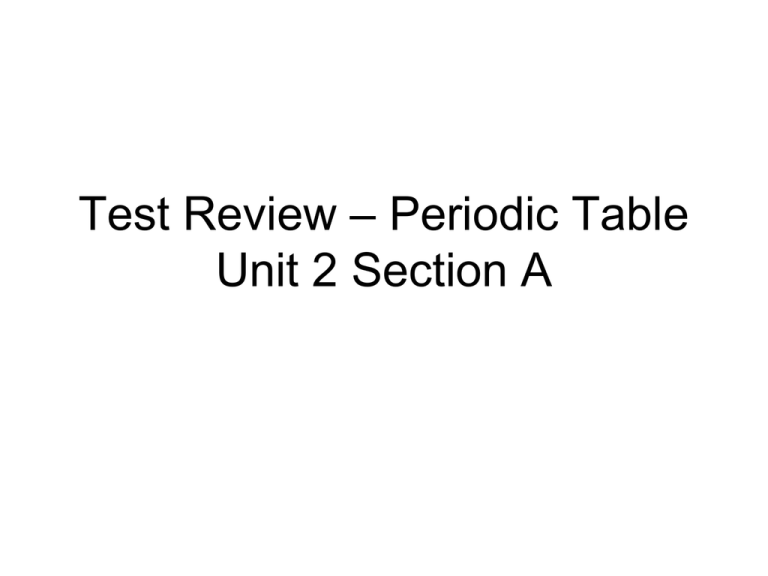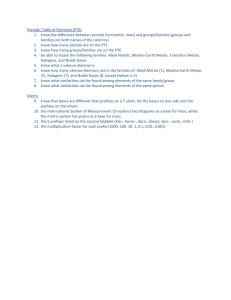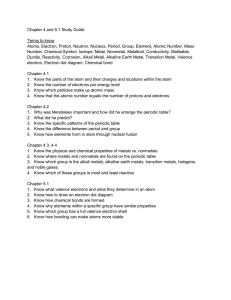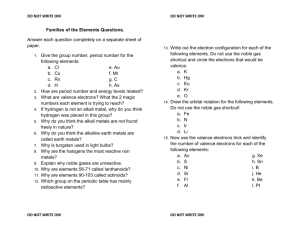The name given to all the elements on the left side of the periodic
advertisement

Test Review – Periodic Table Unit 2 Section A Use your periodic table to enter the symbol of the element for each of the following questions. The name given to all the elements on the left side of the periodic table which have from 1 to 3 valence electrons, conduct electricity and heat, are malleable and ductile. Metals The name given to all the elements on the right side of the periodic table which have from 5 to 7 valence electrons, do not conduct electricity or heat, and are brittle in texture. Nonmetals The name given to all the elements on the border of metals and nonmetals which are not malleable or ductile, and sometimes can conduct electricity (semiconductors) Metalloids The vertical columns of the periodic table. These groups share common characteristics and are placed in these columns by their number of valence electrons. Families (groups) The horizontal rows of the periodic table. These tell the number of electron shells or energy levels for each element. Periods The name given to the electrons found in the outside shell of each atom. Valence electrons These are the group IA elements with 1 valence electron in their outside shell. Alkali metals These are the group IIA elements with 2 valence electrons in their outside shell. Alkali Earth Metals These are the group VII A elements with 7 valence electrons in their outside shell. Halogens These are the group VIII A or group 0 elements with 8 valence electrons in their outside shell. They have filled outside shells and are inert. Noble Gases These are the Group B metals. They are not very reactive and their valence electrons can change from 1 to 3. They resist corrosion and are used for coins and jewelry. Transition metals These groups include large elements which are sometimes radioactive and some are synthetically made. Rare earth metals The family of most reactive metals. Alkali metals The family of most reactive nonmetals Halogens The family of least reactive elements all of which are gases. Noble gases Examples of this family include Be, Mg, and Ca. Alkali earth metals Examples of this family include Cl, Br, F, and I Halogens Examples of this family include Cu, Ag, Au, Fe, and Zn. Transition metals Examples of this family include He, Ne, Ar, and Kr. Noble gases Examples of this family include Li, Na, and K Alkali metals Examples of this family include Uranium, Plutonium, and Curium. Rare earth metals Examples of this family include B, Si, As, and Ge, Metalloids Name the halogen in period 4. Name the halogen in period 4. Name the halogen in period 4. Br Name the alkali metal in period 2. Name the alkali metal in period 2. Name the alkali metal in period 2. Li Name an element with properties similar to Neon. Name an element with properties similar to Neon. He, Ar, Kr, Xe, or Rn Which element has 8 protons? Which element has 8 protons? O Which element has 20 electrons? Which element has 20 electrons? Ca Which element has 24 neutrons? Which element has 24 neutrons? 44.956 = 45 45 – 21 = 24 Sc - Scandium 44.956 = 45 45 – 21 = 24 Which element has an atomic mass (weight) closest to 56? Which element has an atomic mass (weight) closest to 56? Fe Name the alkaline earth metal in period 3. Name the alkaline earth metal in period 3. Mg Which period 3 element is the most reactive metal? Which period 3 element is the most reactive metal? Na Which period 2 element is the most reactive nonmetal? Which period 2 element is the most reactive nonmetal? F Which element has 2 more protons than Iron? Which element has 2 more protons than Iron? Iron = Fe = 26 26 + 2 = 28 Ni Iron = Fe = 26 26 + 2 = 28 What is the least reactive period 4 element? What is the least reactive period 4 element? Kr Which two elements are in the same family and have properties most similar to Zinc? Which two elements are in the same family and have properties most similar to Zinc? Cd and Hg For each of the following Groups (Families) state; 1) The # of valence e-, 2) The Group #, 3) Defining characteristics, 4) Example Alkali Metals: 1) 2) 3) 4) For each of the following Groups (Families) state; 1) The # of valence e-, 2) The Group #, 3) Defining characteristics, 4) Example Alkali Metals: 1) 1 2) IA 3) Most reactive metals; combine with Halogens 4) Na, K 5) Outer e- config: *s1 For each of the following Groups (Families) state; 1) The # of valence e-, 2) The Group #, 3) Defining characteristics, 4) Example Alkali Earth Metals: 1) 2) 3) 4) For each of the following Groups (Families) state; 1) The # of valence e-, 2) The Group #, 3) Defining characteristics, 4) Example Alkali Earth Metals: 1) 2 2) IIA 3) +2 charge 4) Ca, Mg 5) Outer e- config: *s2 For each of the following Groups (Families) state; 1) The # of valence e-, 2) The Group #, 3) Defining characteristics, 4) Example Transition Metals: 1) 2) 3) 4) For each of the following Groups (Families) state; 1) The # of valence e-, 2) The Group #, 3) Defining characteristics, 4) Example Transition Metals: 1) 1-3 2) Group B 3) Valence varies, resist corrosion 4) Cu, Ag, Au, Zn, Fe 5) Sublevel orbital block = d For each of the following Groups (Families) state; 1) The # of valence e-, 2) The Group #, 3) Defining characteristics, 4) Example Rare Earth Metals: 1) 2) 3) 4) For each of the following Groups (Families) state; 1) The # of valence e-, 2) The Group #, 3) Defining characteristics, 4) Example Rare Earth Metals: 1) 1-3 2) Group B 3) Large, synthetic, radioactive 4) U, La, Ac 5) Sublevel orbital block = f For each of the following Groups (Families) state; 1) The # of valence e-, 2) The Group #, 3) Defining characteristics, 4) Example Metalloids: 1) 2) 3) 4) For each of the following Groups (Families) state; 1) The # of valence e-, 2) The Group #, 3) Defining characteristics, 4) Example Metalloids: 1) 3-7 2) IIIA-VIIA 3) Semi-metals, Semiconductors 4) Si, B, As 5) Outer e- config: *s2 *p1 - *s2 *p5 For each of the following Groups (Families) state; 1) The # of valence e-, 2) The Group #, 3) Defining characteristics, 4) Example Halogens: 1) 2) 3) 4) For each of the following Groups (Families) state; 1) The # of valence e-, 2) The Group #, 3) Defining characteristics, 4) Example Halogens: 1) 7 2) VIIA 3) Most reactive nonmetals 4) Cl, Br 5) Outer e- config: *s2 *p5 For each of the following Groups (Families) state; 1) The # of valence e-, 2) The Group #, 3) Defining characteristics, 4) Example Noble Gases: 1) 2) 3) 4) For each of the following Groups (Families) state; 1) The # of valence e-, 2) The Group #, 3) Defining characteristics, 4) Example Noble Gases : 1) 8 2) VIIIA or 0 3) Inert, least reactive 4) Ne, Kr 5) Outer e- config: *s2 *p6 • Explain how the sizes of atomic radii change as you travel down and across the periodic table: • Explain how the sizes of atomic radii change as you travel down and across the periodic table: • Sizes increase going down table • Sizes decrease going left to right Size increases going down table Size decreases going left to right Smallest Largest Place these elements in order of increasing atomic radii size: P, Cl, Fr, Mg, K = Place these elements in order of increasing atomic radii size: P, Cl, Fr, Mg, K = Cl, P, Mg, K, Fr • Explain how the electronegativity of atom change as you travel down and across the periodic table: • Explain how the electronegativity of atom change as you travel down and across the periodic table: • Electronegativity decreases going down table • Electronegativity increases going left to right Electronegativity decreases going down table Electronegativity increases going left to right Highest Lowest Place these elements in order of decreasing electronegativity: Ca, Br, As, Cl, Rb = Place these elements in order of decreasing electronegativity: Ca, Br, As, Cl, Rb = Cl, Br, As, Ca, Rb • Which two Groups (families) are most reactive and why? • Which two Groups (families) are most reactive and why? • 1) Alkali metals – Group 1A – only 1 valence electron • 2) Halogens – Group VII A – 7 valence electrons • What is the main property of noble gases and why? • What is the main property of noble gases and why? • Inert – Don’t react • 8 valence electrons (octet) in outside shell, filled outer shells. • Why do all elements in a group (or family) have similar properties? • Why do all elements in a group (or family) have similar properties? • Same number of outside or valence electrons, so same reactivity.






